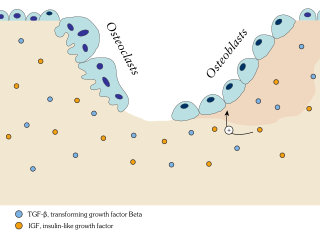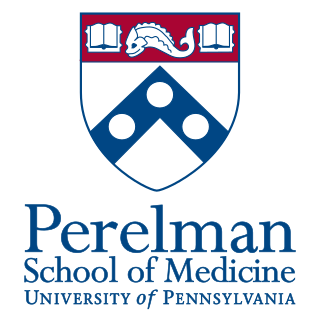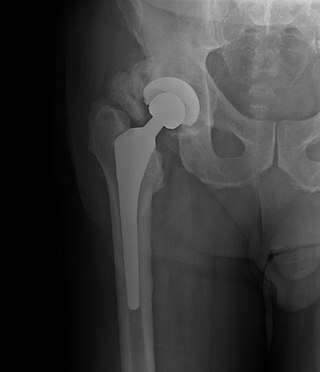
Frederick S. Kaplan is an American medical doctor specializing in research of musculoskeletal disorders such as fibrodysplasia ossificans progressiva (FOP). [1]

Frederick S. Kaplan is an American medical doctor specializing in research of musculoskeletal disorders such as fibrodysplasia ossificans progressiva (FOP). [1]
Frederick Kaplan received a bachelor's degree from Johns Hopkins University in 1972. He also obtained his Doctor of Medicine (MD) from Johns Hopkins University, graduating in 1976. [2]
In the mid 1980s, Kaplan met David Romanoff, the medical director of the Inglis House—a residential care facility for adults with disabilities. Two residents of the facility were diagnosed with fibrodysplasia ossificans progressiva (FOP), a very rare medical condition in which the soft tissue of the body ossifies, or turns to bone, over time. Romanoff was "grappling" with caring for the patients, and asked Kaplan if he would like to meet them, which he did. This was his first encounter with the disease beyond reading about it. [3]
In 1988, Kaplan met immunologist and geneticist Michael Zasloff; Zasloff introduced him to a patient with FOP, a young child. [4] [3] Kaplan stated that his reaction to meeting the young patient was "visceral and immediate", causing him to request a three-year sabbatical from his work so that he could begin to research FOP. [3] Together, Zasloff and Kaplan collaborated to create the FOP Collaborative Research Project at the University of Pennsylvania. [5] In 1992, Kaplan and Eileen Shore initiated the FOP Research Laboratory.
In 2006, Shore and Kaplan discovered the cause of FOP, publishing their findings as "A recurrent mutation in the BMP type I receptor ACVR1 causes inherited and sporadic fibrodysplasia ossificans progressiva". [6] The cause of the disease was traced to a single mutation in the activin A receptor, type I gene. [7] After the discovery, Kaplan remarked, "It took our team of researchers and collaborators more than 15 years of diligent effort to unravel the genetic cause of FOP, which had been shrouded in mystery for so long." [5]
As of 2015, Kaplan and Shore were the directors of the Center for Research in FOP and Related Disorders. They are considered the "world’s foremost experts on FOP". [5]
In 1994, Kaplan and his colleagues authored a publication describing a new muscoskeletal disorder, progressive osseous heteroplasia (POH). [8] POH was discovered as a distinct condition when Kaplan was investigating FOP. Some of the patients initially diagnosed with FOP were found to have a distinctly different manifestation of symptoms, though, like FOP, the disease still resulted in heterotopic ossification (formation of bone tissue outside the skeleton). None of the patients had congenital abnormalities of the big toe, which is a diagnostic feature for FOP. All of the patients also had ossification of the skin during infancy, which did not occur in FOP. Also, the pattern of ossification was different in these patients, spreading in an intramembranous fashion rather than endochondral. [9]
In 2006, the magazine Newsweek named Kaplan as one of their "15 People Who Make America Great". [10] In 2009, he was elected to the National Academy of Medicine. [11] In 2017, Kaplan received the Rare Impact Award from the National Organization for Rare Disorders. [1] In 2018, he received the Grand Hamdan International Award via the Sheikh Hamdan bin Rashid Al Maktoum Award for Medical Sciences for his work in medical sciences. [11]

Primrose syndrome is a rare, slowly progressive genetic disorder that can vary symptomatically between individual cases, but is generally characterised by ossification of the external ears, learning difficulties, and facial abnormalities. It was first described in 1982 in Scotland's Royal National Larbert Institution by Dr D.A.A. Primrose.

Ossification in bone remodeling is the process of laying down new bone material by cells named osteoblasts. It is synonymous with bone tissue formation. There are two processes resulting in the formation of normal, healthy bone tissue: Intramembranous ossification is the direct laying down of bone into the primitive connective tissue (mesenchyme), while endochondral ossification involves cartilage as a precursor.

Fibrodysplasia ossificans progressiva is an extremely rare connective tissue disease in which fibrous connective tissue such as muscle, tendons, and ligaments turn into bone tissue. It is the only known medical condition where one organ system changes into another. It is a severe, disabling disorder with no current cure or treatment.

The Perelman School of Medicine, commonly known as Penn Med, is the medical school of the University of Pennsylvania, a private research university in Philadelphia, Pennsylvania. Founded in 1765, the Perelman School of Medicine is the oldest medical school in the United States and is one of the seven Ivy League medical schools. Penn Med is consistently one of the top recipients of NIH research awards and is currently ranked sixth for research among American medical schools by U.S. News & World Report.

Myositis ossificans comprises two syndromes characterized by heterotopic ossification (calcification) of muscle. The World Health Organization, 2020, has grouped myositis ossificans together with fibro-osseous pseudotumor of digits as a single specific entity in the category of fibroblastic and myofibroblastic tumors.

Heterotopic ossification (HO) is the process by which bone tissue forms outside of the skeleton in muscles and soft tissue.
Ipsen is a French biopharmaceutical company headquartered in Paris, France, with a focus on transformative medicines in three therapeutic areas: oncology, rare disease and neuroscience. Ipsen is one of the world’s top 15 biopharmaceutical companies in terms of oncology sales.

Activin A receptor, type I (ACVR1) is a protein which in humans is encoded by the ACVR1 gene; also known as ALK-2. ACVR1 has been linked to the 2q23-24 region of the genome. This protein is important in the bone morphogenic protein (BMP) pathway which is responsible for the development and repair of the skeletal system. While knock-out models with this gene are in progress, the ACVR1 gene has been connected to fibrodysplasia ossificans progressiva, a disease characterized by the formation of heterotopic bone throughout the body. It is a bone morphogenetic protein receptor, type 1.

Fibroblast growth factor receptor 3 is a protein that in humans is encoded by the FGFR3 gene. FGFR3 has also been designated as CD333. The gene, which is located on chromosome 4, location q16.3, is expressed in tissues such as the cartilage, brain, intestine, and kidneys.
Bone disease refers to the medical conditions which affect the bone.

Activin and inhibin are two closely related protein complexes that have almost directly opposite biological effects. Identified in 1986, activin enhances FSH biosynthesis and secretion, and participates in the regulation of the menstrual cycle. Many other functions have been found to be exerted by activin, including roles in cell proliferation, differentiation, apoptosis, metabolism, homeostasis, immune response, wound repair, and endocrine function. Conversely, inhibin downregulates FSH synthesis and inhibits FSH secretion. The existence of inhibin was hypothesized as early as 1916; however, it was not demonstrated to exist until Neena Schwartz and Cornelia Channing's work in the mid-1970s, after which both proteins were molecularly characterized ten years later.

Harry Raymond Eastlack, Jr. was the subject of the most recognized case of FOP from the 20th century. His case is also particularly acknowledged, by scientists and researchers, for his contribution to medical advancement. After suffering from a rare, disabling, and currently incurable genetic disease, Eastlack decided to have his skeleton and medical history donated to the Mütter Museum of the College of Physicians of Philadelphia in support of FOP research. His skeleton is one of the few FOP-presenting, fully articulated ones in existence, and it has proved valuable to the study of the disease.
Progressive osseous heteroplasia is a cutaneous condition characterized by cutaneous or subcutaneous ossification.
The International Fibrodysplasia Ossificans Progressiva Association (IFOPA) is a US-based 501(c)(3) non-profit organization supporting medical research, education and communication for those afflicted by the rare genetic condition Fibrodysplasia Ossificans Progressiva (FOP). IFOPA's mission is to fund research to find a cure for FOP while supporting, connecting, and advocating for individuals with FOP and their families, and raising awareness worldwide. IFOPA is governed by a volunteer board of directors which may range in number from 9 to 15, at least one of whom must have FOP. The association's location is 1520 Clay St., Suite H2, North Kansas City, MO, 64116, part of the Kansas City, Missouri metropolitan area.
Opsismodysplasia is a type of skeletal dysplasia first described by Zonana and associates in 1977, and designated under its current name by Maroteaux (1984). Derived from the Greek opsismos ("late"), the name "opsismodysplasia" describes a delay in bone maturation. In addition to this delay, the disorder is characterized by micromelia, particularly of the hands and feet, delay of ossification, platyspondyly, irregular metaphyses, an array of facial aberrations and respiratory distress related to chronic infection. Opsismodysplasia is congenital, being apparent at birth. It has a variable mortality, with some affected individuals living to adulthood. The disorder is rare, with an incidence of less than 1 per 1,000,000 worldwide. It is inherited in an autosomal recessive pattern, which means the defective (mutated) gene that causes the disorder is located on an autosome, and the disorder occurs when two copies of this defective gene are inherited. No specific gene has been found to be associated with the disorder. It is similar to spondylometaphyseal dysplasia, Sedaghatian type.
Michael A. Zasloff is an American physician, medical researcher, and entrepreneur. Zasloff is primarily known for his work on antimicrobial peptides.

Palovarotene, sold under the brand name Sohonos, is a medication used for the treatment of heterotopic ossification (HO) and fibrodysplasia ossificans progressiva (FOP). It is a highly selective retinoic acid receptor gamma (RARγ) agonist.

FOP Friends, formerly Friends of Oliver, is a registered charity in the United Kingdom established on 1 March 2012. It aims to raise funds that are needed to find effective treatments for the rare genetic condition Fibrodysplasia Ossificans Progressiva (FOP). The charity also works to raise awareness and understanding of FOP amongst medical communities and the general public.

Eileen M. Shore is an American medical researcher and geneticist specializing in research of muscoskeletal disorders such as fibrodysplasia ossificans progressiva.
Carol Orzel was an American woman with fibrodysplasia ossificans progressiva (FOP). She advocated for research into FOP and was an activist for disability rights. Before her death, she requested that her skeleton be displayed in the Mütter Museum.